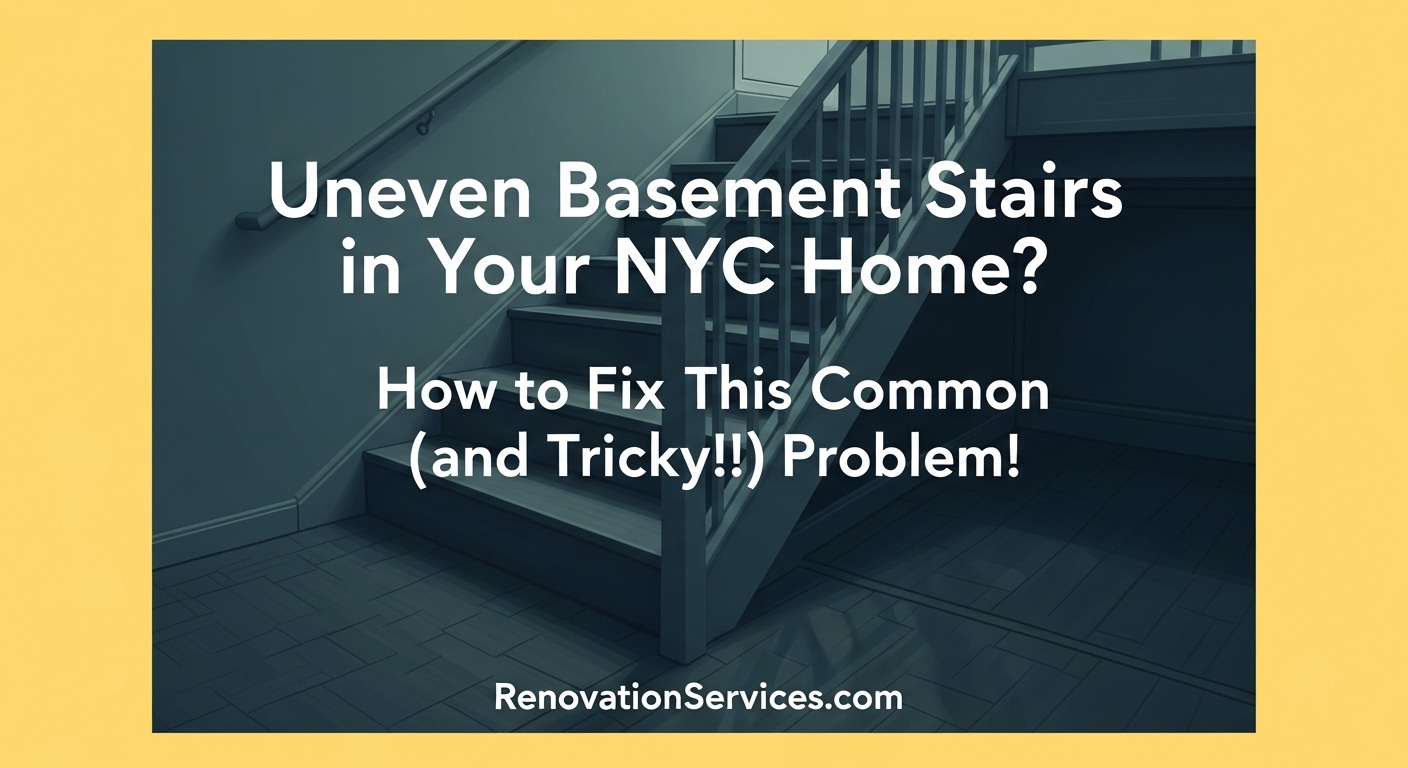Uneven Basement Stairs in Your NYC Home? How to Fix This Common (and Tricky!) Problem!
Do the stairs leading down to your basement in Manhattan, Brooklyn, or another NYC borough feel a little... off? Maybe one step feels much shorter than the others, especially that last one? This is a super common issue in many basements, particularly during renovations in older Queens or Staten Island homes. Not only can uneven basement stairs NYC be a tripping hazard, but they can also cause big problems with city building codes and inspections! The good news is, there's a smart way to fix it. This guide will explain this common basement problem and show you a professional method to make your stairs safe and code-compliant, often by creating a new landing. While some parts might seem DIY-friendly, this kind of structural work often needs expert help from pros like RenovationServices.com, especially to ensure you meet all NYC basement stair code requirements.
1. What's the Big Deal with Uneven Basement Stairs in NYC? (Safety & Code!)
You might think a slightly shorter step at the bottom of your basement stairs isn't a huge issue. However, in New York City, and pretty much everywhere else, building codes are very strict about stairs. Why? Because uneven steps are a major safety hazard! Our brains get used to steps being the same height. So, when one is different, it's easy to misjudge, trip, and fall. This is especially true for uneven basement stairs NYC where lighting might not always be perfect.
Why Consistent Step Height (Riser Height) is Law
Building codes, like the ones enforced by the NYC Department of Buildings (DOB), say that the height of each step in a staircase (called the "riser height") must be very consistent. Usually, the difference between the tallest and shortest step in a flight of stairs can't be more than 3/8 of an inch! That's a tiny amount! If your uneven basement stairs NYC have a last step that's, say, 2 inches shorter than the others because a new floor was put in the basement, that's a definite code violation and a safety risk.
Diagram: Key NYC Stair Code Requirements (Illustrative Summary)
| Stair Element | Typical NYC Code Guideline (Check Current DOB Code) |
|---|---|
| Maximum Riser Height | Usually around 7 3/4 inches to 8 1/4 inches (varies by building type) |
| Minimum Tread Depth | Usually 9 to 11 inches (excluding nosing) |
| Max. Variation in Riser Height (within one flight) | Typically 3/8 inch |
| Max. Variation in Tread Depth (within one flight) | Typically 3/8 inch |
| Minimum Headroom | Usually 6 feet 8 inches |
| Note: These are general guidelines. Always refer to the current official NYC Building Code for precise requirements for your specific property type and project. You can search for codes on the NYC DOB website. | |
If an inspector sees this during a renovation or if you're selling your home in Manhattan or Brooklyn, it can fail an inspection. This could mean costly delays or having to redo work. Therefore, fixing uneven basement stairs NYC isn't just about looks; it's about safety and following the law.
Common Causes of Uneven Basement Steps in NYC Homes
Why does this problem happen so often, especially in basements throughout Queens, Staten Island, and Long Island?
- New Basement Floor Added: Often, when a basement is finished or a new concrete slab is poured, the new floor level becomes higher than the original. This makes that last step down to the basement much shorter than all the others.
- Settling of the House: Over many years, old NYC houses can settle a bit, and this can sometimes make stairs uneven.
- Previous DIY "Fixes": Sometimes, past owners might have tried to fix or change the stairs without understanding the code, making things worse.
No matter the cause, if your stairs aren't consistent, it's a problem that needs a proper solution to meet NYC basement stair code.
Next time you go down your basement stairs, pay attention! Do all the steps feel about the same height? Is that last one a surprise drop or a tiny step? This little check can tell you if you might have this common NYC basement problem.
2. The Pro Solution: Why Creating a Landing Fixes Uneven Stairs
So, you've got uneven basement stairs NYC, and that last step is way too short. You can't just add a little piece of wood to it – that usually doesn't meet code and can look funny. What do the pros do? A very common and smart solution is to change that last short step into a proper **landing**. This is a key technique to fix uneven basement steps NYC correctly.
What is a Landing and How Does it Help?
A landing is basically a flat platform area at the bottom (or sometimes in the middle) of a staircase. By building a landing that's the same height as what the *last full step should have been*, you effectively create a new, shorter staircase that ends *on top* of this landing. Then, from the landing, you have a new, single, code-compliant step down to your basement floor.
Think of it like this: your old stairs had, say, 10 steps, but the 10th one was too short. By building a landing at the height of where the 9th step ends, your old staircase now effectively has 9 good steps leading to the landing. Then, the landing itself becomes the "top" of a brand new, one-step staircase down to the basement floor. This new single step can then be made the correct height!
Diagram: Fixing Uneven Steps with a New Landing
Stairs
Step 1 (Normal)
Step 2 (Normal)
...
Step 9 (Normal)
Step 10 (Too Short!)
Basement Floor
Stairs
Step 1 (Normal)
Step 2 (Normal)
...
Step 9 (Normal)
NEW LANDING (at height of old Step 9)
New Step (Correct Height!)
Basement Floor
Meeting NYC Building Code with a Landing
This landing solution is great because it helps you meet the strict NYC basement stair code. The NYC Department of Buildings (DOB) generally requires landings to be a certain size. A common minimum size for a landing at the bottom of stairs is often around 36 inches by 36 inches (3 feet by 3 feet). This gives you enough space to stand comfortably before taking the next step or turning.
By building this landing, you are essentially "resetting" the staircase. The flight of stairs leading *to* the landing must have consistent riser heights. Then, the step *from* the landing down to the basement floor is treated as a new step (or part of a new, very short flight of stairs), and its height can be made to match the others or be a standalone code-compliant step. This is a very common and accepted way to fix uneven basement steps NYC and pass inspections.
This method is particularly useful in older homes in Manhattan or Brooklyn where original construction might not meet today's precise standards, especially after decades of settling or previous alterations.
8. Can You Install This Yourself, or Should You Call an NYC Pro?
After learning about how to fix uneven basement stairs NYC by building a landing, you might be wondering if this is a DIY project you can handle. It's a fair question! While some very experienced DIYers with strong carpentry and framing skills might consider it, this type of job often involves structural elements and needs to be perfectly level and code-compliant. For most NYC homeowners, calling professionals like the team at RenovationServices.com is usually the best and safest choice.
Why This Project Can Be Tricky for DIYers:
- Structural Work: Modifying stair stringers (the angled supports for the steps) and building a sturdy, load-bearing landing requires a good understanding of framing and structural support. Mistakes here can be dangerous.
- Precise Measurements & Leveling: Getting the landing perfectly level and ensuring all new step heights meet the strict NYC basement stair code (that 3/8-inch max variation!) takes precision. Even small errors can lead to problems.
- Working with Existing Structures: NYC basements, especially in older homes in Manhattan or Brooklyn, can have uneven concrete floors or walls that aren't perfectly square. Pros know how to work around these challenges.
- Code Knowledge: Understanding and correctly applying all the details of the NYC Building Code for stairs, landings, handrails, and headroom can be complex. Professionals stay up-to-date on these codes. You can try to research them on the NYC DOB website, but it's a lot to digest.
- Tools & Materials: This job requires specific tools like circular saws, framing nailers (sometimes), heavy-duty drills, levels, and squares. Pros have these; buying them for one job can be expensive. They also know the right type of lumber (like pressure-treated for contact with concrete) and fasteners to use.
- Time Commitment: This isn't a quick weekend fix. It can take several days of focused work, even for experienced carpenters.
When to Call RenovationServices.com for Your Uneven Basement Stairs:
If any of the above points make you hesitant, or if you simply want the peace of mind that the job is done right, safely, and to code, it's time to call in the experts. RenovationServices.com can help with:
- Expert Assessment: We'll look at your uneven basement stairs NYC and figure out the best way to fix them, whether it's building a new landing or another solution.
- Code-Compliant Design & Build: Our experienced team knows the NYC basement stair code and will make sure your new stairs and landing are safe and legal.
- Professional Carpentry & Framing: We have the skills to modify stringers, build sturdy landings, and ensure everything is perfectly level and secure.
- Handling Any Needed Permits: If the scope of your basement renovation (including the stair fix) requires an NYC renovation permit, we can help guide you through that process.
- Saving You Time & Stress: We handle the whole job, so you don't have to worry about it!
Fixing uneven basement stairs NYC is an important safety upgrade and can make your basement much more usable. While the video shows how it's done, for a project with structural implications and strict code requirements, professional help is often the smartest investment.
Think about your own DIY experience. Do you feel comfortable accurately cutting structural wood (like a stringer)? Can you build a perfectly level and square platform that can safely hold weight? Being honest about your skills helps you decide if this is a job for you or for the pros!
10. Your Uneven NYC Basement Stair Questions Answered!
Even after learning about fixing uneven basement stairs NYC, you might still have a few questions. Here are some common ones we hear at RenovationServices.com:
Q1: How much does it typically cost to fix uneven basement stairs by building a landing in NYC?
A: The cost can vary a lot depending on the size of the landing needed, the complexity of modifying your existing stairs, the materials used, and whether other work (like new flooring or handrails) is also being done. For a professional job in NYC, it could range from a few thousand dollars for a straightforward landing construction to more if significant structural changes or extensive refinishing are involved. The best way to know is to get a detailed quote from a company like RenovationServices.com.
Q2: Will fixing my uneven basement stairs NYC always require a building permit?
A: Often, yes, especially if you are altering the structure of the staircase (like cutting a stringer) or building a new landing. Modifying stairs typically falls under work that requires an NYC renovation permit from the Department of Buildings (DOB) to ensure it meets safety codes. It's always best to check with the DOB or a qualified professional.
Q3: How long does it take to build a new landing and fix uneven basement stairs?
A: For professionals, the actual construction of a landing and modifying the stairs might take a few days to a week, depending on the complexity. However, if permits are needed, the planning and approval process with the NYC DOB can add several weeks or even months to the timeline before work can begin.
Q4: If I build a landing, will I lose a lot of space in my NYC basement?
A: A code-compliant landing usually needs to be at least 36 inches by 36 inches. So yes, it will take up some floor space at the bottom of your stairs. However, this is often a necessary trade-off for having safe, comfortable, and legal stairs. Sometimes, the space under a new landing can even be cleverly used for a bit of storage!
Q5: What if my basement floor itself is very uneven where the landing needs to go?
A: This is a common issue in older NYC basements! Professional installers know how to address this. They might need to shim the landing frame carefully to make it perfectly level, or in some cases, a small section of the concrete floor might need to be leveled first. The video mentioned using floor leveling compound as one solution for creating an even surface. RenovationServices.com can assess this and include any necessary floor leveling in the project plan.
Ready for Safe, Code-Compliant Basement Stairs in Your NYC Home?
Tripping on uneven basement stairs NYC is no fun, and failing a building inspection is even worse! If your basement stairs in Manhattan, Brooklyn, Queens, Staten Island, or Long Island aren't up to par, let the experts at RenovationServices.com help.
We can assess your situation, design a solution (like building a proper landing), and make sure your stairs are safe, comfortable, and meet all NYC basement stair code requirements. Don't risk a fall or a failed inspection!
Get your basement stairs fixed right:
Call Us: (347) 455-1741 Email for Your Free Stair Assessment






